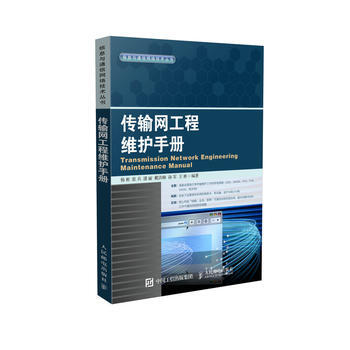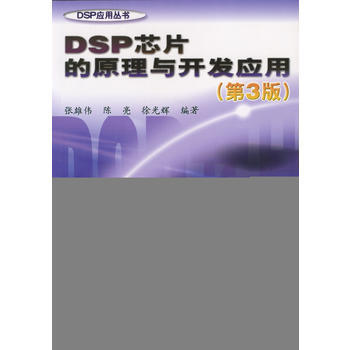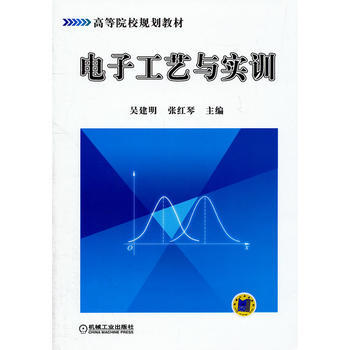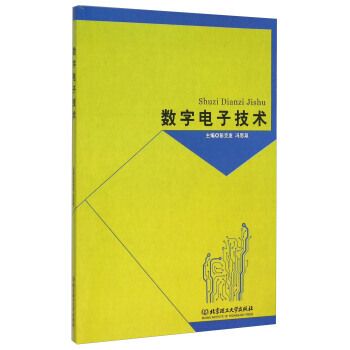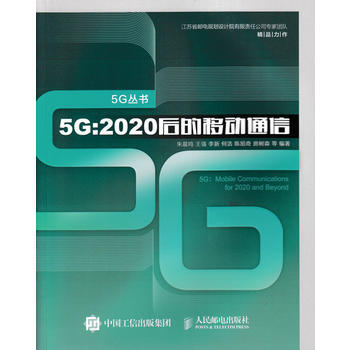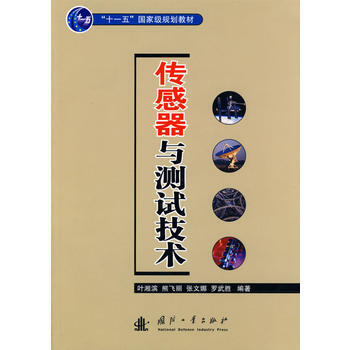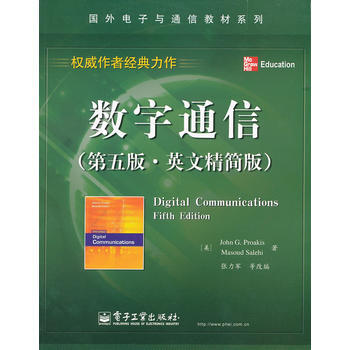

具體描述
基本信息
書名:數字通信(第五版 英文精簡版)
定價:59.00元
作者:(美)普羅科斯,(美)薩利希,張力軍 等改編
齣版社:電子工業齣版社
齣版日期:2012-01-01
ISBN:9787121153259
字數:
頁碼:
版次:1
裝幀:平裝
開本:
商品重量:0.781kg
編輯推薦
內容提要
本書是在《數字通信(第五版)》的基礎上,根據的實際教學情況進行精簡和改編的。主要的精簡原則為:保留信號傳輸理論內容,捨去信息傳輸理論內容,並以傳統而經典的數字傳輸理論為主,無綫通信為輔。改編的部分主要是根據實際教學的常用習慣來進行的。精簡後的內容主要涵蓋:確定與*信號分析;數字調製方法;AWGN信道的*接收機;載波和符號同步;通過帶限信道的數字通信;自適應均衡;多信道和多載波係統;數字通信用擴頻信號;衰落信道:信道特徵與信號傳輸;多天綫係統。
目錄
Chapter 1Introduction
1.1 Elements of a Digital CommunicationSystem
1.2 Communication Channels and TheirCharacteristics
1.3 Mathematical Models for CommunicationChannels
1.4 A Historical Perspective in the Development of
Digitalommunications
Chapter 2 Deterministic and Random SignalAnalysis
2.1 Representation of Bandpass Signals andSystems
2.1–1 Representation of Bandpass Signals/ 2.1–2 Response of aBandpass System to a Bandpass Signal
2.2 Signal Space Representation ofWaveforms
2.2–1 Vector Space Concepts / 2.2–2 Signal Space Concepts / 2.2–3Orthogonal Expansions of Signals /2.2–4 Gram-SchmidtProcedure
2.3 Some Useful RandomVariables
2.4 RandomProcesses
2.4–1 Wide-Sense Stationary Random Processes /2.4–2Cyclostationary Random Processes
2.5 Series Expansion of RandomProcesses
2.5–1 Sampling Theorem for Band-Limited RandomProcesses /2.5–2 TheKarhunen-Lo`eve Expansion
2.6 Bandpass Stationary StochasticProcesses
Problems
Chapter 3 Digital ModulationSchemes
3.1 Representation of Digitally ModulatedSignals
3.2 Memoryless ModulationMethods
3.2–1 Pulse Amplitude Modulation (PAM) / 3.2–2 Phase Modulation /3.2–3 Quadrature Amplitude Modulation /3.2–4 MultidimensionalSignaling
3.3 Signaling Schemes withMemory
3.3–1 Continuous-Phase Frequency-Shift Keying(CPFSK) /
3.3–2 Continuous-Phase Modulation (CPM)
3.4 Power Spectrum of Digitally ModulatedSignals
3.4–1 Power Spectral Density of a Digitally ModulatedSignalwith
Memory / 3.4–2 Power Spectral Density of LinearlyModulated
Signals / 3.4–3 Power Spectral Density ofDigitally Modulated
Signals with Finite Memory / 3.4–4Power Spectral Density of
Modulation Schemes with a MarkovStructure / 3.4–5 Power
Spectral Densities of CPFSK and CPM Signals
Problems
Chapter 4 Optimum Receivers for AWGNChannels
4.1 Waveform and Vector ChannelModels
4.1–1 Optimal Detection for a General Vector Channel
4.2 Waveform and Vector AWGNChannels
4.2–1 Optimal Detection for the Vector AWGN Channel /4.2–2Implementation of the Optimal Receiver for AWGN Channels / 4.2–3 AUnion Bound on the Probability of Error of Maximum LikelihoodDetection
4.3 Optimal Detection and Error Probability for Band-Limited
Signaling
4.3–1 Optimal Detection and Error Probability for ASK or
PAM Signaling / 4.3–2 Optimal Detection and ErrorProbability
for PSK Signaling / 4.3–3 Optimal Detection and ErrorProbability
for QAM Signaling / 4.3–4 Demodulation and Detection
4.4 Optimal Detection and Error Probability forPower-Limited
Signaling
4.4–1 Optimal Detection and Error Probability for Orthogonal
Signaling / 4.4–2 Optimal Detection and Error Probabilityfor
Biorthogonal Signaling / 4.4–3 Optimal Detection and Error
Probability for Simplex Signaling
4.5 Optimal Detection in Presence of Uncertainty:Noncoherent
Detection
4.5–1 Noncoherent Detection of Carrier Modulated Signals /4.5–2Optimal Noncoherent Detection of FSK Modulated Signals / 4.5–3Error Probability of Orthogonal Signaling with NoncoherentDetection / 4.5–4 Probability of Error for Envelope Detection ofCorrelated Binary Signals /4.5–5 Differential PSK (DPSK)
4.6 A Comparison of Digital SignalingMethods
4.6–1 Bandwidth and Dimensionality
4.7 Lattices and Constellations Based onLattices
4.7–1 An Introduction to Lattices / 4.7–2 Signal Constellationsfrom Lattices
4.8 Detection of Signaling Schemes withMemory
4.8–1 The Maximum Likelihood Sequence Detector
4.9 Optimum Receiver for CPMSignals
4.9–1 Optimum Demodulation and Detection of CPM /4.9–2 Performanceof CPM Signals / 4.9–3 Suboptimum Demodulation and Detection of CPMSignals
Problems
Chapter 5 Carrier and SymbolSynchronization
5.1 Signal ParameterEstimation
5.1–1 The Likelihood Function / 5.1–2 Carrier Recovery and
Symbol Synchronization in Signal Demodulation
5.2 Carrier PhaseEstimation
5.2–1 Maximum-Likelihood Carrier Phase Estimation /5.2–2 ThePhase-Locked Loop / 5.2–3 Effect of AdditiveNoise on the PhaseEstimate / 5.2–4 Decision-Directed Loops / 5.2–5Non-Decision-Directed Loops
5.3 Symbol TimingEstimation
5.3–1 Maximum-Likelihood Timing Estimation /5.3–2Non-Decision-Directed Timing Estimation
5.4 Joint Estimation of Carrier Phase and SymbolTiming
5.5 Performance Characteristics of MLEstimators
Problems
Chapter 6 Digital Communication Through Band-LimitedChannels
6.1 Characterization of Band-LimitedChannels
6.2 Signal Design for Band-LimitedChannels
6.2–1 Design of Band-Limited Signals for No Intersymbol
Interference—The Nyquist Criterion / 6.2–2 Design of Band-LimitedSignals with Controlled ISI—Partial-Response Signals / 6.2–3 DataDetection for Controlled ISI /6.2–4 Signal Design for Channels withDistortion
6.3 Optimum Receiver for Channels with ISI andAWGN
6.3–1 Optimum Maximum-Likelihood Receiver /6.3–2 A Discrete-TimeModel for a Channel with ISI /6.3–3 Maximum-Likelihood SequenceEstimation (MLSE)
for the Discrete-Time White Noise Filter Model
6.4 LinearEqualization
6.4–1 Peak Distortion Criterion /6.4–2 Mean-Square-Error (MSE)Criterion /
6.4–3 Performance Characteristics of the MSE Equalizer /6.4–4Fractionally Spaced Equalizers /6.4–5 Baseband and Passband LinearEqualizers
6.5 Decision-FeedbackEqualization
6.5–1 Coefficient Optimization /6.5–2 Performance Characteristicsof DFE
6.6 Reduced Complexity MLDetectors
Problems
Chapter 7 AdaptiveEqualization
7.1 Adaptive LinearEqualizer
7.1–1 The Zero-Forcing Algorithm /7.1–2 The LMS Algorithm /7.1–3Convergence Properties of the LMS Algorithm /7.1–4 Excess MSE dueto Noisy Gradient Estimates /7.1–5 Accelerating the InitialConvergence Rate
in the LMS Algorithm / 7.1–6 Adaptive Fractionally SpacedEqualizer—The Tap Leakage Algorithm /7.1–7 An Adaptive ChannelEstimator for ML
Sequence Detection
7.2 Adaptive Decision-FeedbackEqualizer
7.3 Recursive Least-Squares Algorithms for AdaptiveEqualization
7.3–1 Recursive Least-Squares (Kalman) Algorithm /7.3–2 LinearPrediction and the Lattice Filter
Problems
Chapter 8 Multichannel and MulticarrierSystems
8.1 Multichannel Digital Communications in AWGNChannels
8.1–1 Binary Signals / 8.1–2 M-ary Orthogonal Signals
8.2 MulticarrierCommunications
8.2–1 Single-Carrier Versus Multicarrier Modulation /8.2–2Capacity of a Nonideal Linear Filter Channel /8.2–3 OrthogonalFrequency Division Multiplexing (OFDM) /8.2–4 Modulation andDemodulation in an OFDM System /
8.2–5 An FFT Algorithm Implementation of an OFDM System /8.2–6Spectral Characteristics of Multicarrier Signals /8.2–7 Bit andPower Allocation in Multicarrier Modulation /8.2–8 Peak-to-AverageRatio in Multicarrier Modulation /8.2–9 Channel CodingConsiderations in Multicarrier Modulation
Problems
Chapter 9 Spread Spectrum Signals for DigitalCommunications
9.1 Model of Spread Spectrum Digital CommunicationSystem
9.2 Direct Sequence Spread SpectrumSignals
9.2–1 Error Rate Performance of the Decoder /9.2–2 SomeApplications of DS Spread Spectrum Signals /9.2–3 Effect of PulsedInterference on DS Spread Spectrum Systems / 9.2–4 Excision ofNarrowband Interference in DS Spread Spectrum Systems / 9.2–5Generation of PN Sequences
9.3 Frequency-Hopped Spread SpectrumSignals
9.3–1 Performance of FH Spread Spectrum Signals in an
AWGN Channel / 9.3–2 Performance of FH Spread Spectrum
Signals in Partial-Band Interference / 9.3–3 A CDMA System
Based on FH Spread Spectrum Signals
9.4 Other Types of Spread SpectrumSignals
Problems
Chapter 10 Fading Channels : Characterization and
Signaling
10.1 Characterization of Fading MultipathChannels
10.1–1 Channel Correlation Functions and Power Spectra /
10.1–2 Statistical Models for Fading Channels
10.2 The Effect of Signal Characteristics on the Choice of aChannelModel
10.3 Frequency-Nonselective, Slowly FadingChannel
10.4 Diversity Techniques for Fading MultipathChannels
10.4–1 Binary Signals / 10.4–2 Multiphase Signals /10.4–3 M-aryOrthogonal Signals
10.5 Signaling over a Frequency-Selective, Slowly FadingChannel:
The RAKEemodulator
10.5–1 A Tapped-Delay-Line Channel Model / 10.5–2 The RAKEDemodulator / 10.5–3 Performance of RAKE Demodulator / 10.5–4Receiver Structures for Channels with IntersymbolInterference
10.6 Multicarrier Modulation(OFDM)
10.6–1 Performance Degradation of an OFDM System due to DopplerSpreading / 10.6–2 Suppression of ICI in OFDM Systems
Problems
Chapter 11 Multiple-AntennaSystems
11.1 Channel Models for Multiple-AntennaSystems
11.1–1 Signal Transmission Through a Slow FadingFrequency-Nonselective MIMO Channel / 11.1–2 Detection of DataSymbols in a MIMO System / 11.1–3 Signal
Transmission Through a Slow Fading Frequency-Selective MIMOChannel
11.2 Spread Spectrum Signals and MulticodeTransmission
11.2–1 Orthogonal Spreading Sequences /11.2–2 Multiplexing GainVersus Diversity Gain /11.2–3 Multicode MIMO Systems
Problems
作者介紹
文摘
序言
用戶評價
說實話,我是一個對排版和版式有一定要求的人。有些書,即使內容再好,如果排版混亂,字體大小不統一,或者圖片模糊不清,都會極大地影響我的閱讀興趣。而這本書,從我看到的第一眼,就給瞭我一種賞心悅目的感覺。字體大小適中,行間距舒適,章節標題醒目,公式和圖錶的排版也非常規範,看起來很專業。甚至連頁眉頁腳的設計,都體現瞭齣版方的用心。我喜歡那種閱讀起來毫不費力的書籍,眼睛不會因為長時間盯著模糊或擁擠的文字而疲勞。這本書在這一點上做得非常齣色,讓我能夠更專注於內容的理解,而不是被糟糕的版式所乾擾。這種細節上的打磨,足以證明齣版方的專業素養和對讀者的尊重,也讓我對這本書的內容質量有瞭更高的期待。
評分這本書的包裝和印刷質量真是無可挑剔,厚實的書脊,紙張也很有分量,拿在手裏沉甸甸的,感覺就是一本值得珍藏的好書。封麵設計也相當有品味,簡潔大氣,一看就不是那種流水綫生産的快餐讀物。翻開扉頁,那股淡淡的油墨香撲鼻而來,瞬間勾起瞭我對知識的渴望。目錄的排版也很清晰,條理分明,讓我一眼就能找到自己感興趣的部分。甚至連章節之間的過渡句,都感覺經過瞭精心打磨,閱讀體驗非常順暢。拿到手裏的時候,我還在猶豫是否要立刻開始閱讀,因為我太想先欣賞一下它本身的美感瞭。書的尺寸也恰到好處,既不會顯得過於笨重,又足以容納豐富的內涵。我甚至想把這本書放在書架的最顯眼的位置,作為一件藝術品來展示。它的整體質感,遠超我的預期,讓我對接下來的閱讀充滿瞭期待,我相信這一定是一次不同尋常的閱讀旅程。
評分我一直覺得,一本真正的好書,不僅僅是文字的堆砌,更是一種思維的啓發,一種觀點的碰撞。這本書的作者(我看到作者名字是普羅科斯),一看就是在這個領域深耕多年的專傢。我非常期待能從他的著作中,學習到他獨特的視角和深刻的見解。我希望這本書能夠不僅僅是知識的傳授,更能引發我更深層次的思考,讓我能夠跳齣書本的框架,形成自己對數字通信的理解。我希望它能夠提齣一些新穎的問題,或者提供一些解決問題的不同思路,讓我能夠獲得一些“頓悟”的時刻。我更希望它能激勵我,去探索更多未知的領域,而不是僅僅滿足於現有的知識。這是一種對智慧的渴求,也是我對一本優秀學術著作的最高期望。
評分我最近在學習一些關於信號處理的理論,市麵上相關的書籍琳琅滿目,但很多都過於理論化,或者講解不夠深入,讓人難以把握核心。直到我偶然間看到這本書的推薦,它強調瞭“英文精簡版”的特點,這讓我眼前一亮。我一直覺得,原版英文的錶達方式往往更直接、更準確,而且精簡版意味著去掉瞭那些可能不那麼核心、但又會增加篇幅的內容,直擊要點。這對於我這種時間寶貴,希望快速掌握關鍵知識的學習者來說,簡直是福音。而且,能夠獲得國外頂尖學者的思想精華,不用費力去閱讀大量的英文文獻,又能保證內容的權威性和前沿性,這讓我對這本書充滿瞭信心。我希望它能夠像一位經驗豐富的導師,用清晰的語言,引導我穿越復雜的數字通信領域,揭示其中的奧秘。
評分作為一名在這個行業摸爬滾打多年的工程師,我見過太多“理論脫離實際”的書籍。很多書寫得高大上,一套套的公式,但真正用到實際工作中,卻發現無從下手。我希望這本書能夠在這方麵有所突破。我期待它能在講解理論的同時,穿插一些經典的案例分析,或者提供一些實際工程中的應用場景。我希望它能夠讓我看到,那些抽象的理論是如何轉化為實際産品的,又是如何在現實世界中發揮作用的。我更希望它能夠給我一些解決實際問題的靈感,或者提供一些值得藉鑒的工程實踐。如果這本書能夠幫助我提升解決實際問題的能力,那麼它就不僅僅是一本教科書,更是一份寶貴的職業財富。
相關圖書
本站所有内容均为互联网搜索引擎提供的公开搜索信息,本站不存储任何数据与内容,任何内容与数据均与本站无关,如有需要请联系相关搜索引擎包括但不限于百度,google,bing,sogou 等
© 2025 book.tinynews.org All Rights Reserved. 静思书屋 版权所有

![電子元器件百寶箱 第2捲 [美] Charles Platt,趙正 pdf epub mobi 電子書 下載](https://pic.tinynews.org/29353844411/5b24c997N1a13cb0e.jpg)




![電子技術完全手冊(第5版) [美]Stan Gibilisco pdf epub mobi 電子書 下載](https://pic.tinynews.org/29354137975/5b24cb38N6225e066.jpg)
